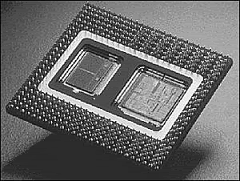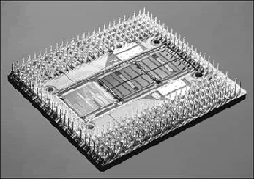Pentium Pro Processors
Intel's successor to the Pentium is called the Pentium Pro. The Pentium Pro was the first chip in the P6 or sixth-generation processor family. It was introduced in November 1995 and became widely available in 1996. The chip is a 387-pin unit that resides in Socket 8, so it is not pin compatible with earlier Pentiums.
The new chip is unique among processors because it is constructed in a multichip module (MCM) physical format, which Intel calls a dual cavity PGA package. Inside the 387-pin chip carrier are two dies. One contains the actual Pentium Pro processor, and the other contains a 256KB, 512KB, or 1MB L2 cache.

The processor die contains 5.5 million transistors, the 256KB cache die contains 15.5 million transistors, and the 512KB cache die(s) have 31 million transistors each—for a potential total of nearly 68 million transistors in a Pentium Pro with 1MB of internal cache! A Pentium Pro with 1MB cache has two 512KB cache die and a standard P6 processor die.

The main processor die includes a 16KB split L1 cache with an 8KB two-way set associative cache for primary instructions and an 8KB four-way set associative cache for data. Another sixth-generation processor feature found in the Pentium Pro is the DIB architecture, which addresses the memory bandwidth limitations of previous-generation processor architectures.
Two buses make up the DIB architecture: the L2 cache bus (contained entirely within the processor package) and the processor-to-main memory system bus. The speed of the dedicated L2 cache bus on the Pentium Pro is equal to the full-core speed of the processor.
This was accomplished by embedding the cache chips directly into the Pentium Pro package. The DIB processor bus architecture addresses processor-to-memory bus bandwidth limitations. It offers up to three times the performance bandwidth of the single-bus, "Socket 7" generation processors, such as the Pentium.
The integrated L2 cache is one of the really outstanding features of the Pentium Pro. By building the L2 cache into the CPU and getting it off the motherboard, the Pentium Pro can now run the cache at full processor speed rather than the slower 60MHz or 66MHz motherboard bus speed.
In fact, the L2 cache features its own internal 64-bit back-side bus, which does not share time with the external 64-bit front-side bus used by the CPU. The internal registers and data paths are still 32-bit, as with the Pentium. By building the L2 cache into the system, motherboards can be cheaper because they no longer require separate cache memory.
Some boards might still try to include cache memory in their designs, but the general consensus is that L3 cache (as it would be called) would offer less improvement with the Pentium Pro than with the Pentium. One of the features of the built-in L2 cache is that multiprocessing is greatly improved.
Rather than just SMP, as with the Pentium, the Pentium Pro supports a new type of multiprocessor configuration called the Multiprocessor Specification (MPS 1.1). The Pentium Pro with MPS enables configurations of up to four processors running together.
Unlike other multiprocessor configurations, the Pentium Pro avoids cache coherency problems because each chip maintains a separate L1 and L2 cache internally. Pentium Pro–based motherboards are pretty much exclusively PCI and ISA bus-based, and Intel has produced its own chipsets for these motherboards.
Because of the greater cooling and space requirements, Intel designed the new ATX motherboard form factor to better support the Pentium Pro and other future processors, such as the Pentium II/III/4. Even so, the Pentium Pro can be found in all types of motherboard designs; ATX is not mandatory.
The Pentium Pro system manufacturers were tempted to stick with the Baby-AT form factor. The big problem with the standard Baby-AT form factor is keeping the CPU properly cooled. The massive Pentium Pro processor consumes more than 25 watts and generates an appreciable amount of heat.
Four special VID pins are on the Pentium Pro processor. These pins can be used to support automatic selection of power supply voltage. Therefore, a Pentium Pro motherboard does not have voltage regulator jumper settings like most Pentium boards, which greatly eases the setup and integration of a Pentium Pro system.
These pins are not actually signals, but are either an open circuit in the package or a short circuit to voltage. The sequence of opens and shorts defines the voltage the processor requires. In addition to allowing for automatic voltage settings, this feature was designed to support voltage specification variations on future Pentium Pro processors.
Most Pentium Pro processors run at 3.3V, but a few run at 3.1V. Note that the 1111 (or all opens) ID can be used to detect the absence of a processor in a given socket.
The Pentium Pro never did become very popular on the desktop, but it did find a niche in file-server applications primarily because of the full-core speed high-capacity internal L2 cache. For a time, Intel offered an OverDrive upgrade processor for the Pentium Pro, but it no longer offers any OverDrive processors. PowerLeap offers several upgrades for Pentium Pro that use 700MHz-class Celeron PPGA processors in an adapter.